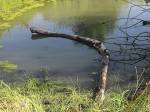Turtle Pond Float is a fix-it landscaping art project turned wildlife habitat installation. This project is an Outdoor Classroom project: Orchard View School; Sunny Galbraith, teacher, and 7 of her Biology students. Location: Laguna Environmental Center. Date of installation project: May 20th, 2015.
The Laguna de Santa Rosa Foundation operates the Laguna Environmental Center, or LEC, on Stone Farm, at 900 Sanford Road, Santa Rosa, California, 95401. This wildlife habitat installation is at the LEC’s (Laguna Environmental Center’s) pond.
We will “fix” the problem of a sunken pond turtle haul out; the log that was installed on the pond’s sloping bank and into the pond last year has sunken below water surface level. Also, we will make the landscaping seem more natural by hiding another log’s unsightly sawcut.
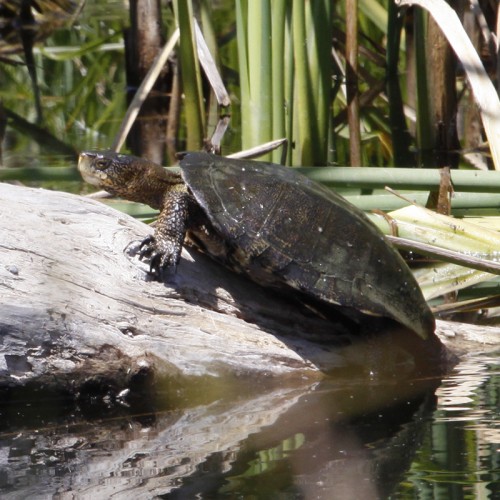 A western pond turtle climbs onto Turtle Pond Pier at the LEC, summer of 2014. The log has since sunken below the pond’s surface.
A western pond turtle climbs onto Turtle Pond Pier at the LEC, summer of 2014. The log has since sunken below the pond’s surface.
Prep for the installation
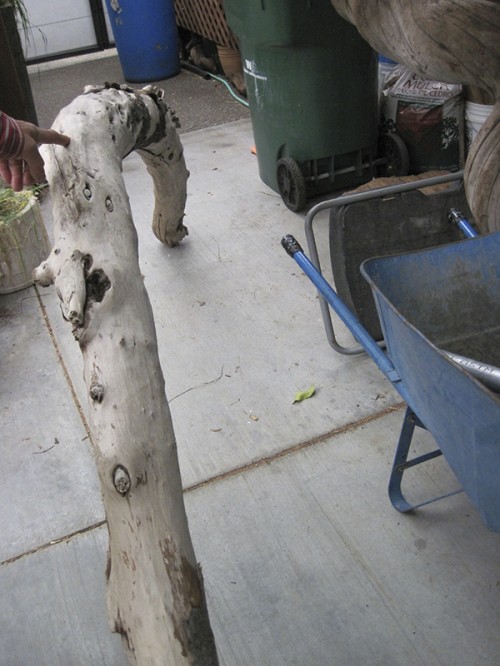 A volunteer steps forward. This eucalyptus arching limb, stored dry for a few years, will become Turtle Pond Float – a haul out and sunning log for Western Pond Turtles and a perch-over-the-pond for birds and flying insects, like dragonflies and damselflies. Note how I am using one finger to hold the arch upright — the log’s center of gravity is being displayed. Understanding the log’s density and center of gravity will help determine where a float (an empty bottle) will be attached to the log’s under side.
A volunteer steps forward. This eucalyptus arching limb, stored dry for a few years, will become Turtle Pond Float – a haul out and sunning log for Western Pond Turtles and a perch-over-the-pond for birds and flying insects, like dragonflies and damselflies. Note how I am using one finger to hold the arch upright — the log’s center of gravity is being displayed. Understanding the log’s density and center of gravity will help determine where a float (an empty bottle) will be attached to the log’s under side.
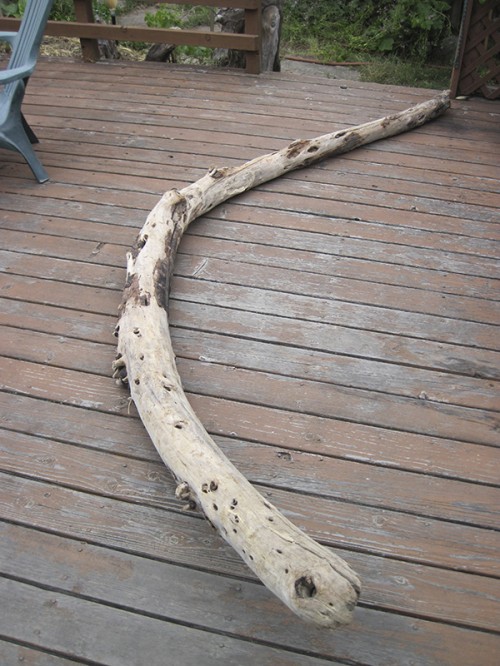 A eucalyptus arched limb comes out of storage. The long arch creates a wide floatable frame; the log will not spin in the water like a more linear log might. Therefore, the log will not roll over in the water and the perch end, foreground, will stay above water. An installed float under the perch end will keep the perch above the pond’s surface.
A eucalyptus arched limb comes out of storage. The long arch creates a wide floatable frame; the log will not spin in the water like a more linear log might. Therefore, the log will not roll over in the water and the perch end, foreground, will stay above water. An installed float under the perch end will keep the perch above the pond’s surface.
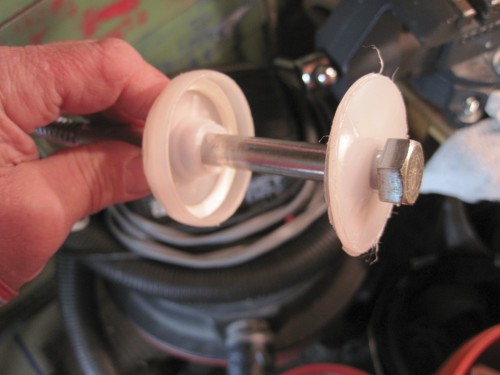 In the workshop, making a tether bolt/washer for Turtle Pond Float. [L to R]: my hand holding a 1/2″ hex head bolt, used cap to a 5-gal water cooler jar, 2″ plastic washer with 1/2″ hole (a 2″ hole saw cut the lid of a 5-gal bucket), the hex head nut.
In the workshop, making a tether bolt/washer for Turtle Pond Float. [L to R]: my hand holding a 1/2″ hex head bolt, used cap to a 5-gal water cooler jar, 2″ plastic washer with 1/2″ hole (a 2″ hole saw cut the lid of a 5-gal bucket), the hex head nut.
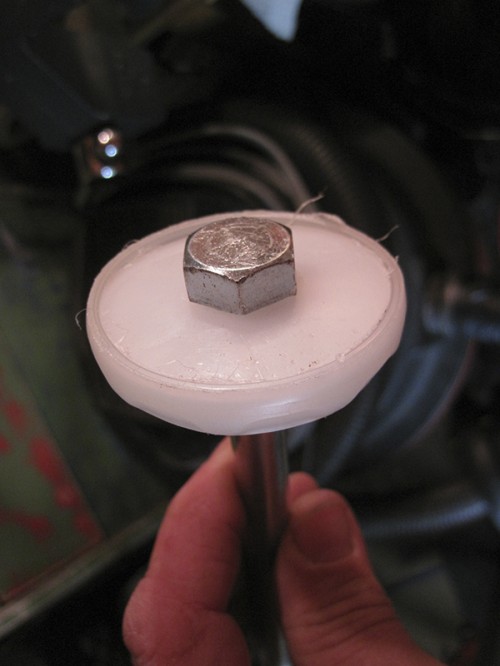 Turtle Pond Float tether snapped together.
Turtle Pond Float tether snapped together.
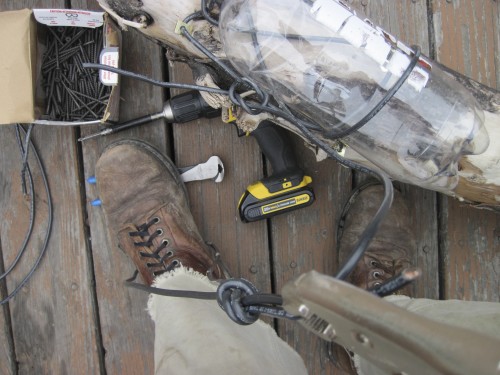 Using salvaged electrical wire and a 2-liter bottle to outfit Turtle Pond Float for the Pond. Note, for the bottle float attachment, four 1/2″ 90-degree metal brackets provide strapping holes for the electrical wire. 2″ deck screws secure the the brackets to the log. The loop of wire in my boot will help me tighten the bottle’s wire knot.
Using salvaged electrical wire and a 2-liter bottle to outfit Turtle Pond Float for the Pond. Note, for the bottle float attachment, four 1/2″ 90-degree metal brackets provide strapping holes for the electrical wire. 2″ deck screws secure the the brackets to the log. The loop of wire in my boot will help me tighten the bottle’s wire knot.
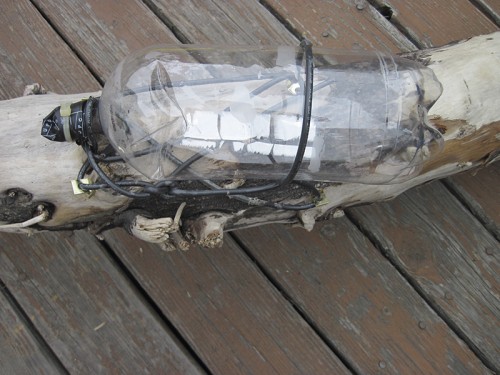 Turtle Pond Float’s bottle float sealed and secured. Ready to go! Note the wire ends tucked under the bottle. Also, the bottle cap was closed down tightly, wrapped with tape, and the tape was then pull-tied. Please don’t leak!
Turtle Pond Float’s bottle float sealed and secured. Ready to go! Note the wire ends tucked under the bottle. Also, the bottle cap was closed down tightly, wrapped with tape, and the tape was then pull-tied. Please don’t leak!
Installation Day
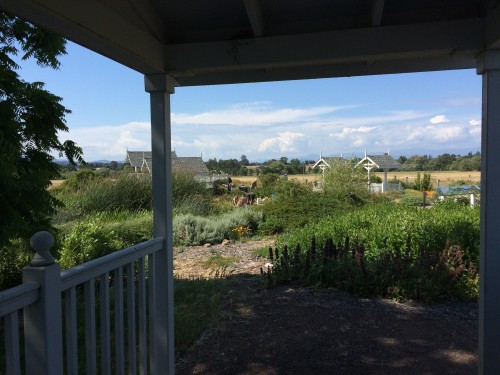 View north from the Laguna Foundation’s back porch. The outdoor classroom project today is across the pond.
View north from the Laguna Foundation’s back porch. The outdoor classroom project today is across the pond.
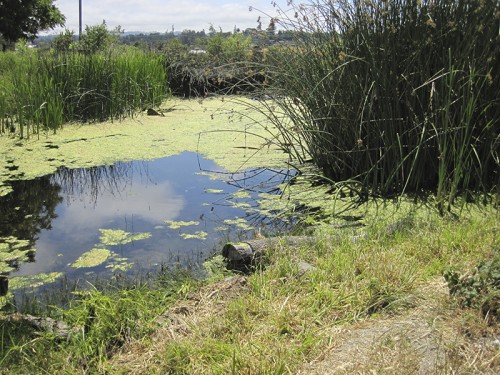 The Before of the wildlife habitat installation, Turtle Pond Float. A bay tree log is beached against the pond’s sedge and juncus rush bank. One of the purposes of this wildlife habitat installation is to relocate/reposition the bay log, AKA, the Bay Log. The landscape will look more natural when Bay Log’s sawcuts are more hidden. Note the abundance of algae on the pond surface. Tule reeds grow out into the pond, left.
The Before of the wildlife habitat installation, Turtle Pond Float. A bay tree log is beached against the pond’s sedge and juncus rush bank. One of the purposes of this wildlife habitat installation is to relocate/reposition the bay log, AKA, the Bay Log. The landscape will look more natural when Bay Log’s sawcuts are more hidden. Note the abundance of algae on the pond surface. Tule reeds grow out into the pond, left.
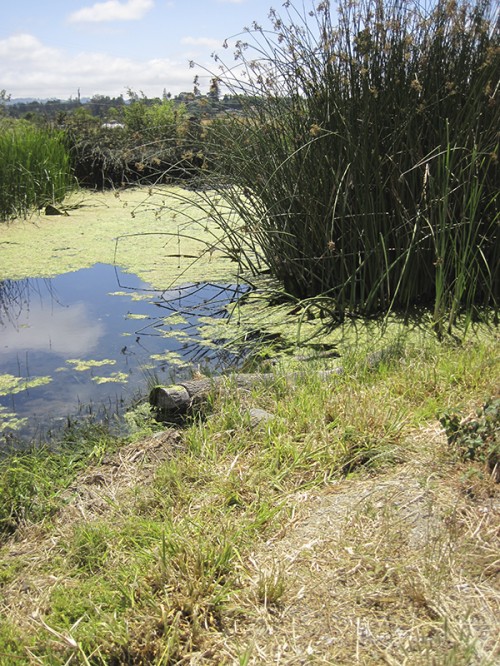 Before, west view. Note the pond surface, May 20, 2015, on installation day. We are moving toward hotter, dryer weather, summer. The pond surface will lower then. Alternatively, the pond level will rise in rainy winter. To keep the turtle haul-out log at a consistent level above the surface, the floating log will be loosely tethered to the shore, which will allow the log to rise and fall as the pond surface does.
Before, west view. Note the pond surface, May 20, 2015, on installation day. We are moving toward hotter, dryer weather, summer. The pond surface will lower then. Alternatively, the pond level will rise in rainy winter. To keep the turtle haul-out log at a consistent level above the surface, the floating log will be loosely tethered to the shore, which will allow the log to rise and fall as the pond surface does.
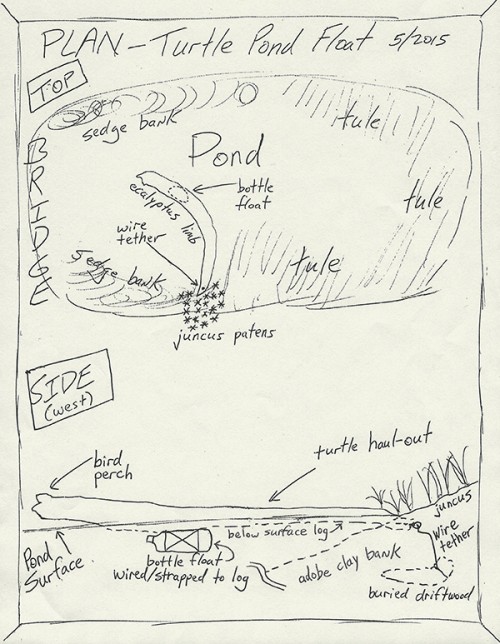 The PLAN — Turtle Pond Float.
The PLAN — Turtle Pond Float.
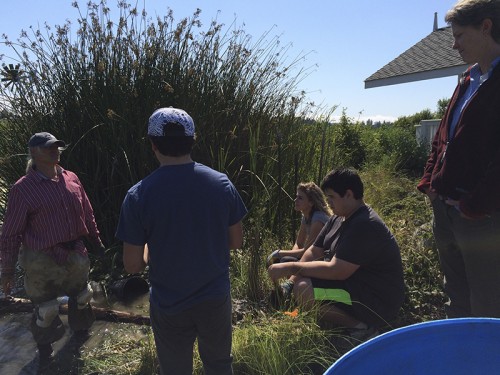 Pondside instruction. We will create a small juncus (Juncus patens, California grey rush) patch growing at the base of two partially buried and partially water saturated logs. Both the mud-to-log and water-to-log interfaces will provide habitat for pond creatures. Larger trophic animals (like turtles, water-loving snakes, salamanders and frogs, and birds) will utilize Turtle Pond Float’s logs as a sunning haul-out, a resting or hunting perch, or a wall in the mud to snuggle up to. Ducks and other shore birds will enjoy the cover of the bankside vegetation.
Pondside instruction. We will create a small juncus (Juncus patens, California grey rush) patch growing at the base of two partially buried and partially water saturated logs. Both the mud-to-log and water-to-log interfaces will provide habitat for pond creatures. Larger trophic animals (like turtles, water-loving snakes, salamanders and frogs, and birds) will utilize Turtle Pond Float’s logs as a sunning haul-out, a resting or hunting perch, or a wall in the mud to snuggle up to. Ducks and other shore birds will enjoy the cover of the bankside vegetation.
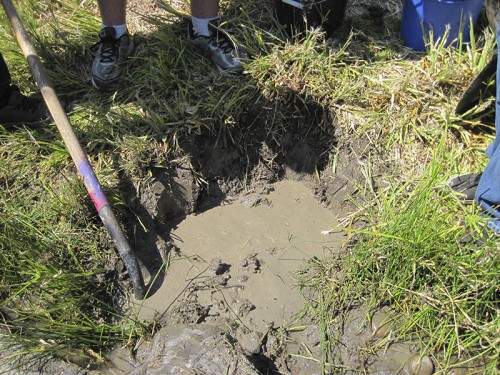 Digging the hole to bury the short (20 inches) tether log. Some of the sedge (Carex barbarae) dug out will return back to the hole. Rocks are collected in a separate bucket; they will be tossed on the tether log before the hole is filled in with mudbank soil, plants, and the end of Bay Log. Many buckets are used to separate out what comes of digging the mudbank hole. Organization now helps safely store away those pondside plants that we may use later. Better to have some resources, like native plants and good alive mud, left over than not enough to finish the project.
Digging the hole to bury the short (20 inches) tether log. Some of the sedge (Carex barbarae) dug out will return back to the hole. Rocks are collected in a separate bucket; they will be tossed on the tether log before the hole is filled in with mudbank soil, plants, and the end of Bay Log. Many buckets are used to separate out what comes of digging the mudbank hole. Organization now helps safely store away those pondside plants that we may use later. Better to have some resources, like native plants and good alive mud, left over than not enough to finish the project.
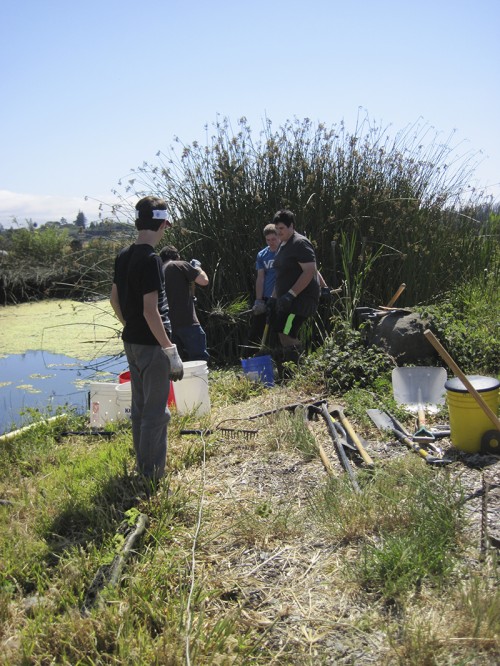 Mucking it up — digging away the bankside for planting and to bury the tether anchor (a sturdy, short branch section).
Mucking it up — digging away the bankside for planting and to bury the tether anchor (a sturdy, short branch section).
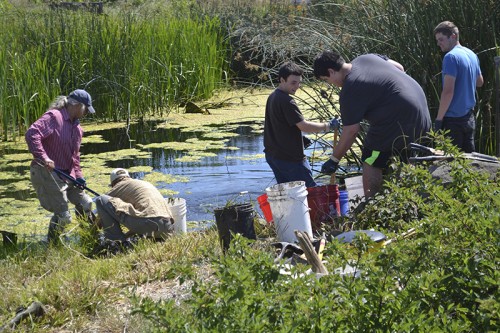 Four teams running. 1—Sedge mudbank diggers (right). 2—Pond algae collectors (left). 3—Field sedge planters (behind, out of view). 4—Historians — thank you photographers Jenna and Anita!
Four teams running. 1—Sedge mudbank diggers (right). 2—Pond algae collectors (left). 3—Field sedge planters (behind, out of view). 4—Historians — thank you photographers Jenna and Anita!
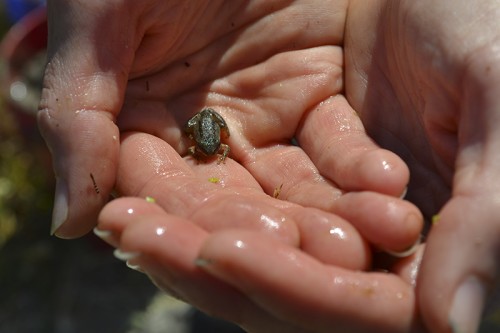 Holding a Pacific Tree Frog (Pseudacris regilla), also known as the Pacific Chorus Frog, found among the sedges. This non-virtual contact with Nature alivens the outdoor classroom project.
Holding a Pacific Tree Frog (Pseudacris regilla), also known as the Pacific Chorus Frog, found among the sedges. This non-virtual contact with Nature alivens the outdoor classroom project.
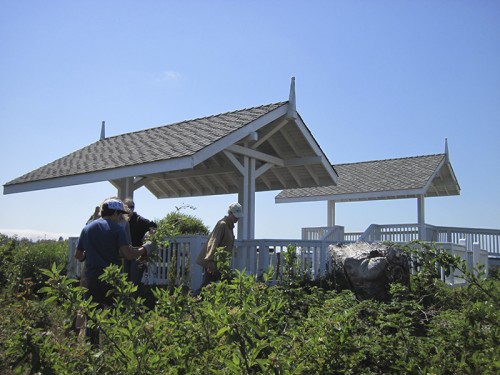 A crew of students (and teacher) weeds up slope from the installation site. Log of Truth, right, which some of these students installed in February of 2014, has grown in nicely.
A crew of students (and teacher) weeds up slope from the installation site. Log of Truth, right, which some of these students installed in February of 2014, has grown in nicely.
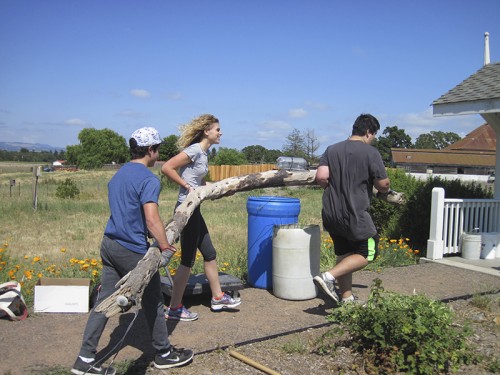 Turtle Haul Out is being moved from its launchpad at the LEC’s Observation Platform’s packed gravel (water permeable) path. Note the eucalyptus limb’s modifications: the bottle float and the tether pin (1/2” bolt with 2” white plastic washer). The students will lower Turtle Pond Float to the installation crew waiting at pondside.
Turtle Haul Out is being moved from its launchpad at the LEC’s Observation Platform’s packed gravel (water permeable) path. Note the eucalyptus limb’s modifications: the bottle float and the tether pin (1/2” bolt with 2” white plastic washer). The students will lower Turtle Pond Float to the installation crew waiting at pondside.
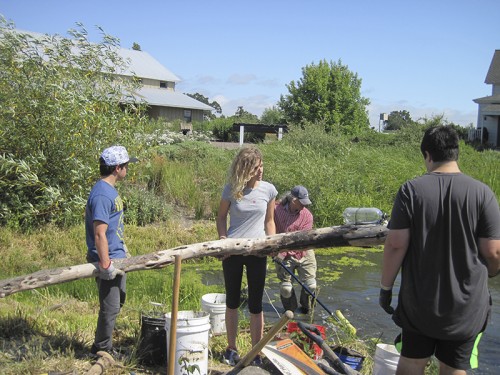 Instruction to the students: Get the log in the water without knocking off the bottle. So far, so good. The bottle end of the limb will go in first, with the float UNDER the log, and will be floated out to the middle of the pond.
Instruction to the students: Get the log in the water without knocking off the bottle. So far, so good. The bottle end of the limb will go in first, with the float UNDER the log, and will be floated out to the middle of the pond.
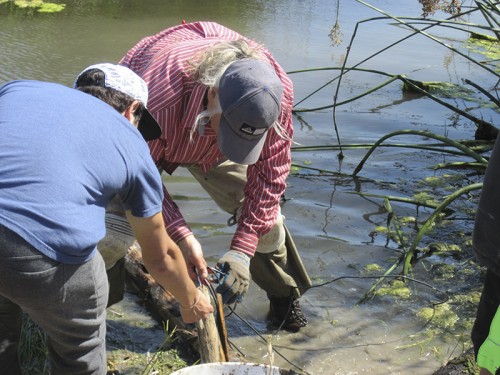 Tying the driftwood “anchor” to Turtle Pond Float using salvaged electrical wire.
Tying the driftwood “anchor” to Turtle Pond Float using salvaged electrical wire.
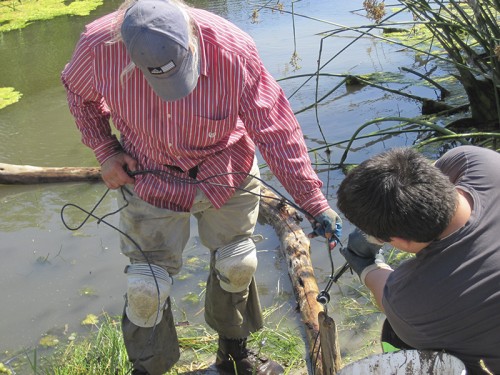 Clipping/cleaning the wire tie tether.
Clipping/cleaning the wire tie tether.
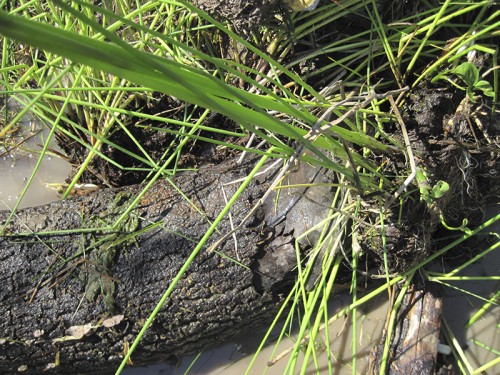 Juncus patens has been planted on top of and next to Bay Log (left, horizontal) and Turtle Pond Float (right bottom). Pond algae was used to mulch the planting. Note that Bay Log’s largest sawcut has been hidden in the reeds. Shhhhh!
Juncus patens has been planted on top of and next to Bay Log (left, horizontal) and Turtle Pond Float (right bottom). Pond algae was used to mulch the planting. Note that Bay Log’s largest sawcut has been hidden in the reeds. Shhhhh!
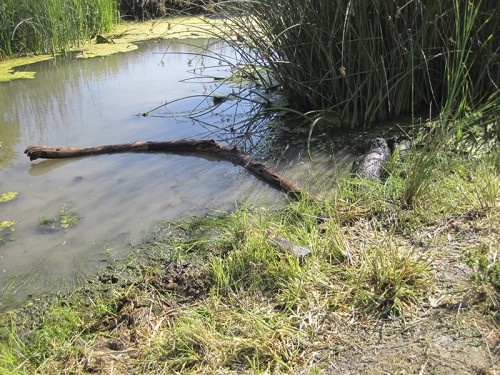 Almost done. The wood limbs are in place and the planting is finished. Note how Turtle Pond Float’s end is above the water’s surface, now.
Almost done. The wood limbs are in place and the planting is finished. Note how Turtle Pond Float’s end is above the water’s surface, now.
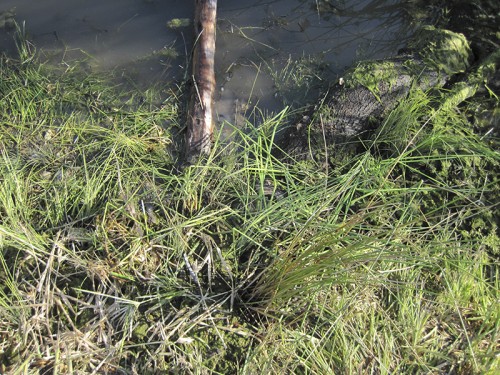 Finishing touches include returning some dead grass and organic debris to the planting AND slopping Bay Log with pond algae (right).
Finishing touches include returning some dead grass and organic debris to the planting AND slopping Bay Log with pond algae (right).
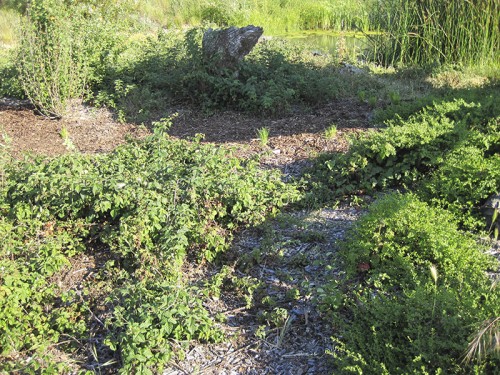 Log of Truth gets some TLC – weeding, planting field sedge (Carex praegegracillus), and mulching with woodchips. Note Turtle Pond Float just right and downhill of Log of Truth. The view is looking south, cross the pond.
Log of Truth gets some TLC – weeding, planting field sedge (Carex praegegracillus), and mulching with woodchips. Note Turtle Pond Float just right and downhill of Log of Truth. The view is looking south, cross the pond.
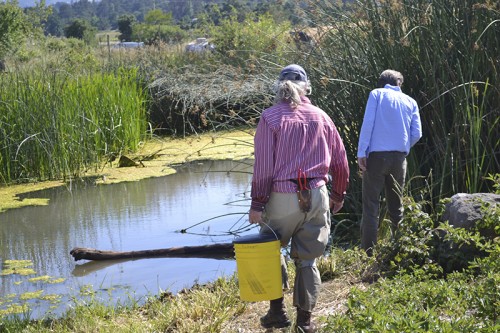 The Laguna Foundation’s Director of Restoration and Conservation Science Programs, Wendy Trowbridge, inspects the completed Turtle Pond Float installation. Hmmmm.
The Laguna Foundation’s Director of Restoration and Conservation Science Programs, Wendy Trowbridge, inspects the completed Turtle Pond Float installation. Hmmmm.
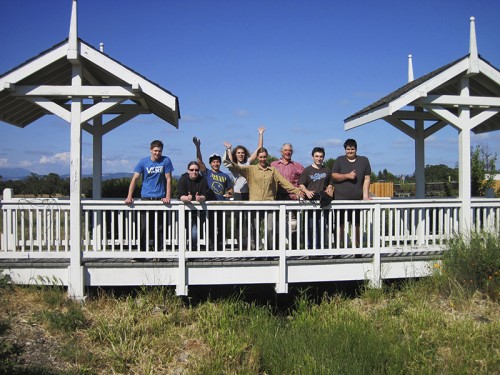 Orchard View Biology students and teacher Sunny Galbraith, and me (Tony McGuigan) celebrate Turtle Pond Float and a successful school year of wildlife habitat installations! We are looking directly at the pond, west view.
Orchard View Biology students and teacher Sunny Galbraith, and me (Tony McGuigan) celebrate Turtle Pond Float and a successful school year of wildlife habitat installations! We are looking directly at the pond, west view.
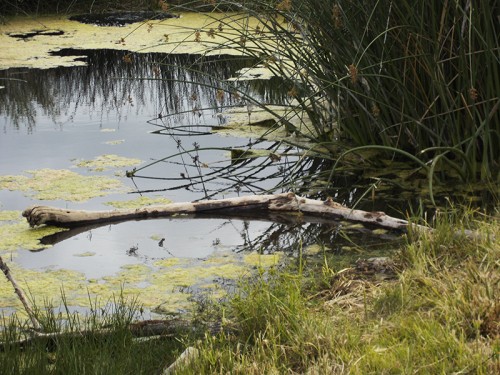 View from the bridge, west, 27 hours after installation. Sunset bathes the pond. Turtle Pond Float will most likely sink an inch or two underwater as it saturates with pond water. However, the air-filled bottle will keep the haul out and sunning perch (left end) afloat. Calling all Western Pond Turtles!
View from the bridge, west, 27 hours after installation. Sunset bathes the pond. Turtle Pond Float will most likely sink an inch or two underwater as it saturates with pond water. However, the air-filled bottle will keep the haul out and sunning perch (left end) afloat. Calling all Western Pond Turtles!
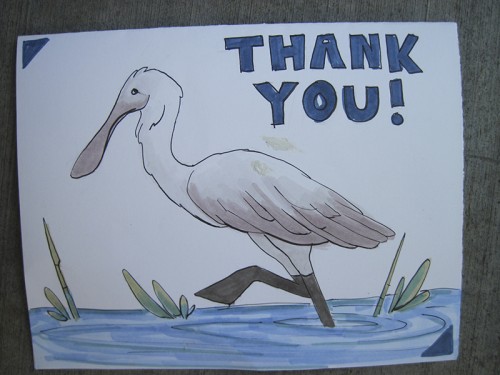 And Thank You, too, Orchard View Biology students and teacher Sunny Galbraith. Nice bird, Cassidy!
And Thank You, too, Orchard View Biology students and teacher Sunny Galbraith. Nice bird, Cassidy!
Enjoy your wildlife habitat creations. Habitat it!
Tony
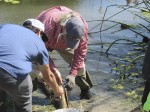
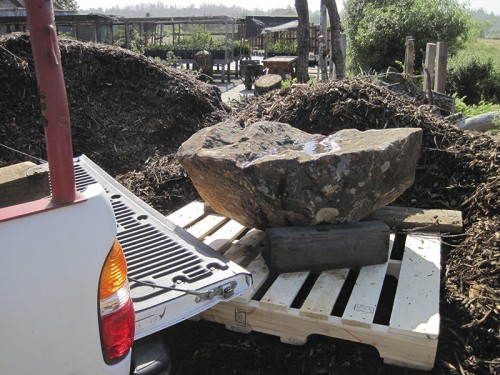 A Sonoma fieldstone landscape boulder on deck for July 12th’s workshop, Creating Residential Wildlife Habitat, at the Laguna Environmental Center. Note the boulder’s ability to hold water — it’s a critter waterhole!
A Sonoma fieldstone landscape boulder on deck for July 12th’s workshop, Creating Residential Wildlife Habitat, at the Laguna Environmental Center. Note the boulder’s ability to hold water — it’s a critter waterhole!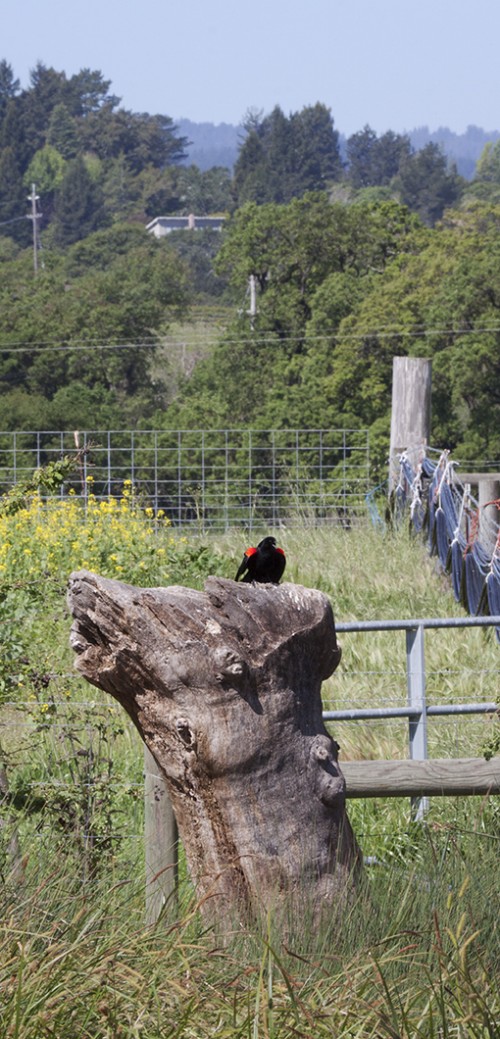 A red-winged blackbird struts his stuff atop Oak Tunnel Tower, a wildlife habitat installed by Tony McGuigan and the students of Orchard View School at the LEC, January 2014.
A red-winged blackbird struts his stuff atop Oak Tunnel Tower, a wildlife habitat installed by Tony McGuigan and the students of Orchard View School at the LEC, January 2014.
